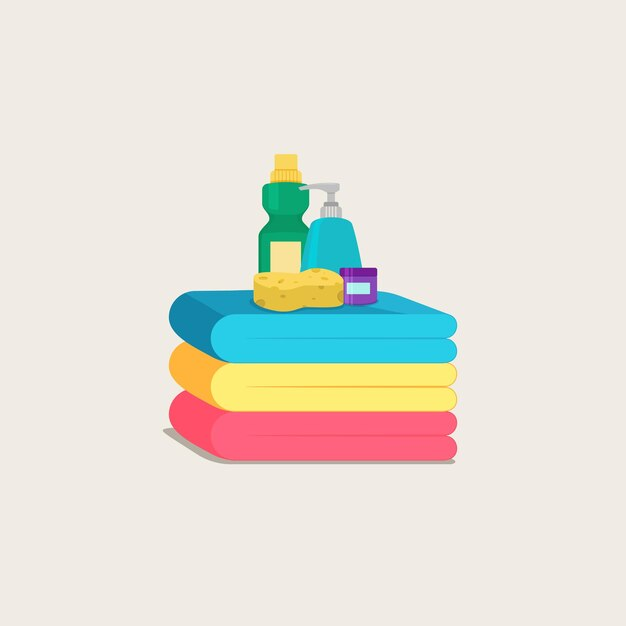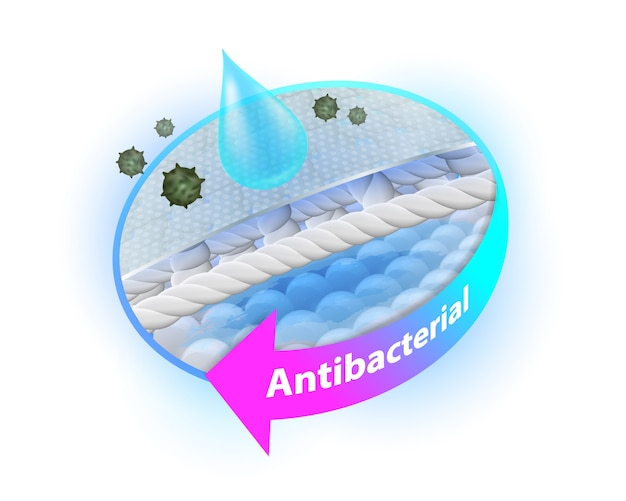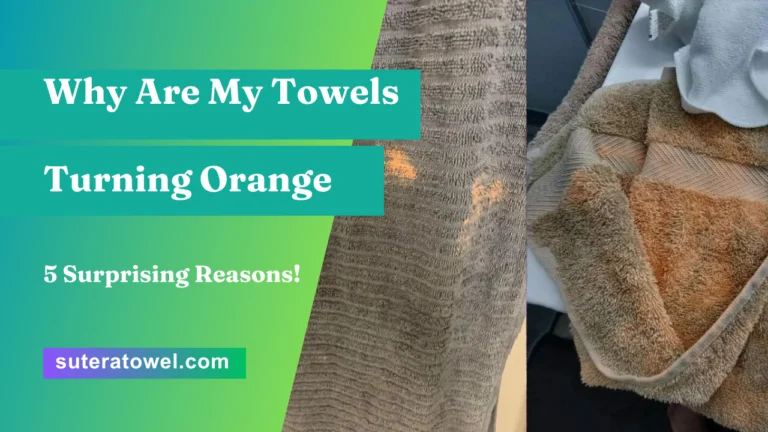The orange color on your towels is likely due to mineral deposits from hard water. In areas with high mineral content in the water, such as iron, the towels can become discolored over time.
If you’ve noticed that your towels are taking on an orange hue, it can be quite perplexing. After all, towels are supposed to be clean and fresh, not discolored. The presence of an orange color on your towels is usually a result of mineral deposits, which can occur when you have hard water.
Hard water is water that contains high levels of minerals like iron, calcium, and magnesium. When these minerals accumulate on your towels, they can cause them to turn an unsightly shade of orange. We will explore the reasons behind the discoloration of towels, discuss the impact of hard water on your laundry, and provide effective solutions to remedy the issue.
The Impact Of Hard Water On Towels

Discover the surprising reason behind your orange towels – hard water. Hard water deposits minerals on your towels, causing them to change color. Find out how to prevent and remove these stains for brighter, fresher towels.
How Hard Water Affects The Color Of Towels
Hard water can have a noticeable impact on the color of your towels. The mineral buildup and discoloration that occurs can leave them looking less than appealing. Understanding how hard water affects the color of towels will help you take the necessary steps to prevent and remove these unsightly stains.
- Mineral buildup and discoloration: When towels come into contact with hard water, minerals such as calcium and magnesium can accumulate on the fabric. Over time, these minerals can cause the towels to turn a dull shade of orange or yellow. The minerals act as a dye, penetrating the fibers of the towel and altering its original color.
- Ways to prevent and remove hard water stains: Thankfully, there are several methods you can use to prevent and remove hard water stains from your towels. Consider the following options:
- Regular maintenance: Ensure that you are regularly washing your towels to prevent mineral buildup. The more frequently you wash your towels, the less time minerals have to attach to the fabric. This will help preserve the original color of your towels.
- Vinegar soak: Soaking your towels in a mixture of water and vinegar can help break down the mineral deposits that cause discoloration. Fill a basin or sink with equal parts water and vinegar, and let the towels soak for at least an hour. Afterward, wash them as usual to remove any remaining residue.
- Baking soda treatment: Baking soda is another effective solution for removing hard water stains. Create a paste by mixing baking soda with water and gently scrub it onto the affected areas of the towel. Allow the paste to sit for a few minutes before rinsing it off and laundering the towels.
- Lemon juice: The acidity in lemon juice can help dissolve mineral buildup on towels. Squeeze fresh lemon juice onto the stained areas and let it sit for a few minutes. Then, rinse the towels thoroughly and wash them as usual.
- Water softener: Investing in a water softener can help prevent mineral buildup not only on your towels but also throughout your entire home. Softened water contains fewer minerals, ensuring that your towels retain their original color for longer periods.
By understanding how hard water affects the color of your towels and implementing these prevention and removal methods, you can keep your towels looking fresh and vibrant for longer. Remember to prioritize regular maintenance and explore different techniques until you find the one that works best for you.
The Role Of Detergents And Fabric Softeners

Discover the mystery behind orange towels as we dig into the role of detergents and fabric softeners. Uncover the culprit and find out how to avoid this frustrating color change.
Have you ever wondered why your once pristine white towels have transformed into a peculiar shade of orange? Fear not, as we delve into the mysteries behind this unusual phenomenon. In this section, we will explore the role of detergents and fabric softeners in the color-changing process, shedding light on the chemical reactions and color transfers that may be the culprit.
Furthermore, we will discuss proper detergent and fabric softener usage for color preservation, ensuring your towels maintain their original brilliance.
Chemical Reactions Between Detergents And Water:
- Mineral deposits: Hard water contains high levels of minerals, such as iron, which can react with the chemicals present in detergents. This chemical reaction can lead to the formation of rust-like particles, imparting an orange hue to your towels.
- Oxidation: Certain detergents contain bleaching agents or enzymes that can cause oxidation reactions when exposed to water. These reactions can alter the color of your towels, especially if they are made from sensitive materials.
Color Transfer From Other Fabrics:
- Dye bleeding: Towels that come into contact with colored fabrics, especially those prone to bleeding dyes, may experience color transfer. This can occur during the washing or drying process, resulting in your towels taking on the color of the other fabric, including shades of orange.
- Fabric friction: When towels rub against garments or other fabrics with intense colors, friction can cause the transfer of tiny pigment particles. Over time, these particles may accumulate, leading to discoloration and the appearance of an orange tint.
Proper Detergent And Fabric Softener Usage For Color Preservation:
- Select a color-safe detergent: Opt for detergents explicitly designed for preserving colors. These detergents often have lower pH levels and gentler cleaning agents, reducing the likelihood of color changes in your towels.
- Separate colors: When washing your towels, separate them from heavily dyed or vibrant garments to minimize the risk of color transfer. This precaution ensures that your towels retain their original color and prevent any orange staining.
- Avoid overloading the machine: Overcrowding the washing machine can hinder proper water circulation. Insufficient water flow can result in inadequate rinsing, potentially leaving behind detergent residues that can contribute to color changes in your towels.
- Skip fabric softener: Fabric softeners may contain additives that can interact with the colors in your towels, causing discoloration. To maintain the vibrancy of your towels, consider skipping fabric softener or using color-safe alternatives.
- Follow care instructions: Always refer to the care labels on your towels for specific washing recommendations. Adhering to these instructions will ensure optimal color preservation and extend the lifespan of your towels.
By understanding the chemical reactions caused by detergents and fabric softeners, as well as the potential for color transfer from other fabrics, you can take proactive steps to prevent your towels from turning orange. Remember to use color-safe detergents, separate colors during washing, and follow care instructions — all of which contribute to preserving the vibrant colors of your towels.
Now, armed with this knowledge, bid farewell to those pesky orange tinges and welcome back the beauty of your towels.
Bacterial Growth And Mold Formation

Tired of your towels turning orange? This color change could be due to bacterial growth and mold formation, which thrive in damp environments. Prevent this by properly drying your towels and regularly washing them with bleach.
Moisture retention in towels:
- Towels have the tendency to retain moisture, especially when they are not properly dried after each use.
- When towels remain damp, it creates the perfect environment for bacterial growth and mold formation.
- The moisture trapped in the towel fibers becomes a breeding ground for bacteria, leading to unpleasant odors and discoloration of the towel fabric.
Bacterial growth and its effect on towel color:
- Bacterial growth on towels can cause them to turn orange or develop dark stains.
- The bacteria produce pigments that can penetrate the towel fibers, resulting in discoloration.
- Certain types of bacteria, such as iron bacteria, can also produce rust-colored deposits on towels.
- These stains are not only unappealing but can also be difficult to remove, even with regular washing.
Preventing bacterial growth and mold formation in towels:
- Wash towels regularly: Regular laundering is essential to remove bacteria and prevent their growth. It is recommended to wash towels after every three to four uses.
- Proper drying: After use, hang the towel in a well-ventilated area to ensure it dries completely. Avoid folding or stacking damp towels, as this can promote the growth of bacteria and mold.
- Avoid overloading the washing machine: Overloading the machine can hinder proper cleaning and rinsing of the towels, leaving behind bacteria and mold spores.
- Use hot water and bleach: Washing towels with hot water and bleach can help kill bacteria and prevent mold formation. Follow the care instructions on the towel label for the correct water temperature and detergent amounts.
- Dry towels in direct sunlight: Sunlight is an excellent natural disinfectant and can help kill bacteria and remove any lingering odors in towels. Hang them outside on a sunny day to benefit from the sunlight’s sanitizing properties.
- Avoid harsh chemicals: While it may be tempting to use strong chemicals to remove stains, they can damage the towel fabric. Stick to mild detergents and avoid using fabric softeners, as they can reduce the towel’s absorbency.
By following these preventive measures, you can maintain the freshness and color of your towels while ensuring they remain free from bacterial growth and mold formation. Keep in mind that regular washing and proper drying are crucial to achieving optimal towel hygiene.
Environmental Factors And Oxidation

Tired of finding orange stains on your towels? Environmental factors, such as iron in water or exposure to sunlight, can lead to oxidation, resulting in the discoloration of your towels. These factors can cause your towels to turn orange over time.
Exposure To Sunlight And Air
- Sunlight and air can both contribute to the orange discoloration of towels. Here’s how:
- Sunlight: ** When towels are exposed to prolonged sunlight, the UV rays can cause the fibers to break down and the dyes to fade, resulting in an orange hue.
- Air: ** The oxygen in the air can also oxidize the towels’ fibers, leading to a color change. This oxidation process is accelerated in the presence of moisture, such as when towels are damp or stored in humid environments.
- To summarize, the combination of sunlight and air can result in the oxidation of towel fibers and the subsequent change in color to orange.
Oxidation Of Towel Fibers
- The process of oxidation involves a chemical reaction between the oxygen in the air and the towel fibers. Here’s what happens:
- Oxygen interaction: ** When the towel fibers come into contact with oxygen, a reaction occurs that alters the chemical composition of the fibers. Over time, this can lead to color changes, including the orange tint.
- Factors influencing oxidation: ** Several factors can contribute to the oxidation of towel fibers, such as exposure to sunlight, humidity, and the presence of certain chemicals, including chlorine bleach.
- Effect on different materials: ** While all towel fibers can undergo oxidation, certain materials, such as cotton, are more prone to this process. This is why cotton towels are more likely to turn orange compared to towels made from synthetic materials.
Protecting Towels From Environmental Factors For Color Preservation
- To preserve the color of your towels and prevent them from turning orange, it’s important to take certain precautionary measures. Consider the following:
- Proper storage: ** Store towels in a cool, dry place away from direct sunlight to minimize their exposure to UV rays and reduce the risk of color fading or oxidation.
- Avoid chlorine bleach: ** Chlorine bleach can accelerate the oxidation process and contribute to the discoloration of towels. Opt for color-safe or oxygen-bleach alternatives instead.
- Regular washing: ** Wash towels regularly to remove any dirt, oils, or environmental pollutants that can interact with the fibers and potentially lead to color changes.
- Gentle detergents: ** Use mild detergents specifically formulated for laundry to prevent abrasive chemicals from damaging the towel fibers and causing unwanted color alterations.
- Consider fabric softeners: ** Fabric softeners can create a protective barrier around the fibers, reducing their exposure to external factors that contribute to oxidation and color changes.
Remember, by implementing these preventive measures, you can maintain the vibrant colors of your towels and prevent them from turning orange due to environmental factors and oxidation.
Chemical Reactions From Skincare Products

The orange discoloration appearing on your towels may be a result of chemical reactions caused by certain skincare products used on your skin.
Chemical Ingredients In Skincare Products:
- Skincare products often contain chemical ingredients that can react with the fabric of towels and cause discoloration. These ingredients can include artificial colors, dyes, fragrances, and preservatives.
- Certain chemical ingredients, such as benzoyl peroxide and salicylic acid, commonly found in acne treatment products, can bleach or stain towels when they come into contact with them.
- Some ingredients in skincare products, like self-tanning products or bronzers, can also transfer onto towels, leaving behind an orange or brown hue.
Interaction Between Skincare Products And Towels:
- When skincare products come into contact with towels, chemical reactions can occur, leading to discoloration. This can happen when the product is still wet on the skin and transfers to the towel or when the towel absorbs residue left from previous use.
- Moisture and heat further enhance the interactions between the ingredients in skincare products and the fabric of towels, intensifying the discoloration process.
Choosing Skincare Products That Won’T Cause Towel Discoloration:
- Opt for skincare products that are labeled as non-comedogenic, meaning they have been formulated not to clog pores. These products are less likely to contain certain ingredients that can cause towel discoloration.
- Look for skincare products that do not contain artificial colors or dyes. These additives can sometimes bleed onto towels and result in unwanted discoloration.
- Consider using skincare products that are fragrance-free or have a light scent. Fragrances often contain ingredients that can react with towels and lead to discoloration.
- Before using any skincare product, carefully read the package instructions and warnings. Some products may explicitly mention potential towel discoloration or provide guidelines for preventing it.
Remember, understanding the chemical ingredients in skincare products, their interaction with towels, and choosing wisely can help you avoid the frustration of towels turning orange.
Frequently Asked Questions On Why Are My Towels Turning Orange
Why Is My Towel Changing Color?
Your towel is changing color due to the reaction of its fibers with water and detergent.
How Do I Stop My Towels From Discoloring?
To prevent towel discoloration, follow these steps: 1. Separate dark and light towels when washing. 2. Use a mild detergent and avoid bleach or fabric softeners. 3. Wash towels in cold water to preserve color. 4. Hang towels in the shade to dry, avoiding direct sunlight.
Why Do My Towels Look Bleached?
Your towels may look bleached due to exposure to harsh chemicals or overuse of bleach.
Why Do My Husband’s Towels Turn Yellow?
Yellowing of towels is caused by factors like excessive use of chlorine bleach, hard water minerals, or sweat and body oils that don’t fully wash out.
Conclusion
To sum up, if you’ve noticed your towels turning orange, it could be due to a variety of factors. One possible cause is the interaction between certain chemicals in your water and laundry detergent, resulting in a chemical reaction that stains the fabric.
Another potential culprit is iron deposits in your water supply, which can oxidize and create a rusty orange color on your towels. It’s also worth considering if you’ve recently used hair or skincare products that contain ingredients like benzoyl peroxide or self-tanner, as these can transfer onto your towels and cause discoloration.
To prevent orange towels, try using a water softener, using a detergent specifically formulated for hard water, or treating your towels with vinegar or lemon juice. Regularly cleaning your washing machine and properly storing your towels will also help maintain their color and quality.
Remember, it’s always important to identify the cause of the issue in order to find the most effective solution.
